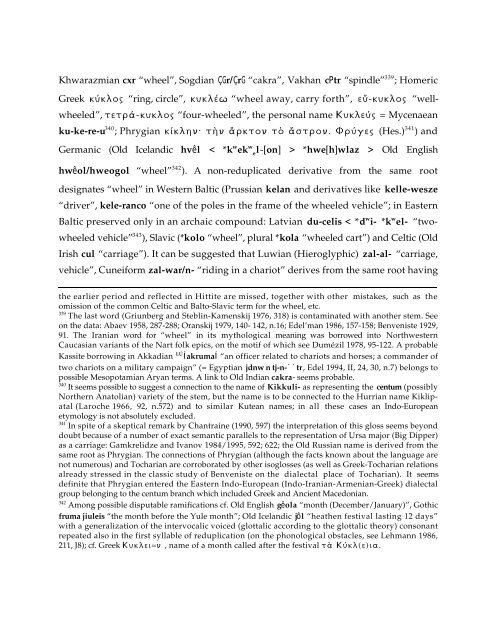Comparative Notes on Hurro-Urartian, Northern Caucasian
Comparative Notes on Hurro-Urartian, Northern Caucasian
Comparative Notes on Hurro-Urartian, Northern Caucasian
You also want an ePaper? Increase the reach of your titles
YUMPU automatically turns print PDFs into web optimized ePapers that Google loves.
Khwarazmian cxr “wheel”, Sogdian ÇGr/ÇrG “cakra”, Vakhan cPtr “spindle” 339 ; Homeric<br />
Greek kÊklow “ring, circle”, kukl°v “wheel away, carry forth”, eÎ-kuklow “well-<br />
wheeled”, tetrã-kuklow “four-wheeled”, the pers<strong>on</strong>al name KukleÊw = Mycenaean<br />
ku-ke-re-u 340 ; Phrygian k¤klhn: tØn êrkt<strong>on</strong> tÚ êstr<strong>on</strong>. FrÊgew (Hes.) 341 ) and<br />
Germanic (Old Icelandic hvêl < *k w ek w<br />
el-[<strong>on</strong>] > *hwe[h]wlaz > Old English<br />
hwêol/hweogol “wheel” 342 ). A n<strong>on</strong>-reduplicated derivative from the same root<br />
designates “wheel” in Western Baltic (Prussian kelan and derivatives like kelle-wesze<br />
“driver”, kele-ranco “<strong>on</strong>e of the poles in the frame of the wheeled vehicle”; in Eastern<br />
Baltic preserved <strong>on</strong>ly in an archaic compound: Latvian du-celis < *d w i- *k w el- “two-<br />
wheeled vehicle” 343 ), Slavic (*kolo “wheel”, plural *kola “wheeled cart”) and Celtic (Old<br />
Irish cul “carriage”). It can be suggested that Luwian (Hieroglyphic) zal-al- “carriage,<br />
vehicle”, Cuneiform zal-war/n- “riding in a chariot” derives from the same root having<br />
the earlier period and reflected in Hittite are missed, together with other mistakes, such as the<br />
omissi<strong>on</strong> of the comm<strong>on</strong> Celtic and Balto-Slavic term for the wheel, etc.<br />
339 The last word (Griunberg and Steblin-Kamenskij 1976, 318) is c<strong>on</strong>taminated with another stem. See<br />
<strong>on</strong> the data: Abaev 1958, 287-288; Oranskij 1979, 140- 142, n.16; Edel’man 1986, 157-158; Benveniste 1929,<br />
91. The Iranian word for “wheel” in its mythological meaning was borrowed into Northwestern<br />
<strong>Caucasian</strong> variants of the Nart folk epics, <strong>on</strong> the motif of which see Dumézil 1978, 95-122. A probable<br />
Kassite borrowing in Akkadian LÚ ÍakrumaÍ “an officer related to chariots and horses; a commander of<br />
two chariots <strong>on</strong> a military campaign” (= Egyptian jdnw n tj-n-˙˙tr, Edel 1994, II, 24, 30, n.7) bel<strong>on</strong>gs to<br />
possible Mesopotamian Aryan terms. A link to Old Indian cakra- seems probable.<br />
340 It seems possible to suggest a c<strong>on</strong>necti<strong>on</strong> to the name of Kikkuli- as representing the centum (possibly<br />
<strong>Northern</strong> Anatolian) variety of the stem, but the name is to be c<strong>on</strong>nected to the Hurrian name Kiklipatal<br />
(Laroche 1966, 92, n.572) and to similar Kutean names; in all these cases an Indo-European<br />
etymology is not absolutely excluded.<br />
341 In spite of a skeptical remark by Chantraine (1990, 597) the interpretati<strong>on</strong> of this gloss seems bey<strong>on</strong>d<br />
doubt because of a number of exact semantic parallels to the representati<strong>on</strong> of Ursa major (Big Dipper)<br />
as a carriage: Gamkrelidze and Ivanov 1984/1995, 592; 622; the Old Russian name is derived from the<br />
same root as Phrygian. The c<strong>on</strong>necti<strong>on</strong>s of Phrygian (although the facts known about the language are<br />
not numerous) and Tocharian are corroborated by other isoglosses (as well as Greek-Tocharian relati<strong>on</strong>s<br />
already stressed in the classic study of Benveniste <strong>on</strong> the dialectal place of Tocharian). It seems<br />
definite that Phrygian entered the Eastern Indo-European (Indo-Iranian-Armenian-Greek) dialectal<br />
group bel<strong>on</strong>ging to the centum branch which included Greek and Ancient Maced<strong>on</strong>ian.<br />
342 Am<strong>on</strong>g possible disputable ramificati<strong>on</strong>s cf. Old English gêola “m<strong>on</strong>th (December/January)”, Gothic<br />
fruma jiuleis “the m<strong>on</strong>th before the Yule m<strong>on</strong>th”; Old Icelandic jôl “heathen festival lasting 12 days”<br />
with a generalizati<strong>on</strong> of the intervocalic voiced (glottalic according to the glottalic theory) c<strong>on</strong>s<strong>on</strong>ant<br />
repeated also in the first syllable of reduplicati<strong>on</strong> (<strong>on</strong> the ph<strong>on</strong>ological obstacles, see Lehmann 1986,<br />
211, J8); cf. Greek Kuklei≈n , name of a m<strong>on</strong>th called after the festival tå KÊkl(e)ia.





